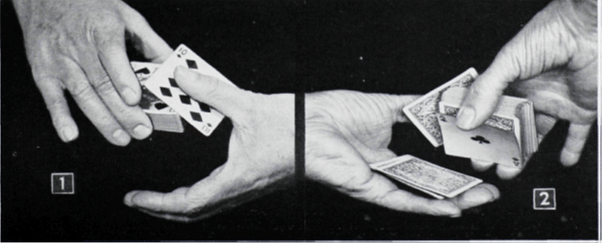Paul Le Paul's Solution for Skip's Trick
By Dominic Twose - Saturday, February 6, 2021
Last month I described Skip’s Trick and promised a solution.
If you know the name Paul LePaul it is probably because of his book The Magic of Paul LePaul, published in 1949. At the time he was recognized as a great card manipulator. He was at the Colon Get Together when the effect was performed, and while he didn’t see it, he heard descriptions of it. The effect appealed to him because it made a really magical effect out of an old sucker gag. But the handling described to him made a practical solution very difficult to find.
He published his solution in The Sphinx, May 1949. In his presentation, the performer explains that he has developed his powers of observation to the extent that he can usually identify a chosen card by the fingerprints on it. He asks a spectator to select a card and hold it a moment between his fingers before returning the card to the pack.
The card is controlled and brought to fourth from the bottom. The deck is then held face up with the right hand holding it from above. The cards are removed one at a time by the left hand, the thumb of this hand drawing each card to the left about half way. The card is then flipped face down into the left hand by the action of raising the deck. As each subsequent card is flipped over, it is pushed slightly to the right with the left thumb as the performer studies the back of the card for a moment as though looking for fingerprints. This movement and the slight hesitancy it involves provides perfect cover for the action that takes place when the fourth card (the card that was selected) is flipped over. This move is a useful variant of a move developed by Elmer Biddle and published under the name ‘Transcendence’ in Genii, Vol. 11 No. 8, April 1947, p. 241. As the fifth card is withdrawn, the selected card is picked up and retained at the bottom of the deck, a slight break being held at the inner end by the tip of the right thumb. The fifth card is then flipped face down in the same manner as the preceding cards. The selected card is thus held face down on the back of the face up deck. The procedure of removing the cards is repeated with several more cards. The performer then appears to be particularly interested in one card, which he studies very carefully. As he flips it face down in the palm of his left hand, the selected card, which has been retained at the back of the deck, is deposited on top of this card. The performer studies the back of the card that lies on top of those in his left hand and discards the rest of the deck. He announces that he has arrived at the decision that this is the selected card. The spectator, having seen the performer pass his card, naturally denies the possibility that this could be his card. But upon after he has named the card, this card is shown to be the correct one, and the balance of the cards are given for inspection.

The effect is a strong one. The method may find appeal because it avoids the multiple double lifts of the Dick Tracy Card Trick. And this handling variant is very practical and could be used in many circumstances.
Back to blog homepage
Similar posts on the blog:

